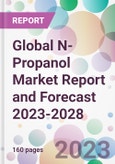N-ropanol, also recognised as 1-Propanol or n-Propyl alcohol, belongs to the family of alcohols and is primarily used as a solvent in the pharmaceutical, cosmetics, and coatings industries. It is a colourless liquid that is miscible with water and exhibits a characteristic alcoholic odour. Its attributes, such as a high evaporation rate, low toxicity, and medium solvency, render it an attractive choice for various applications, from coatings to cleaners and inks.
The extensive use of N-propanol as a solvent in the pharmaceutical sector is one of the primary N-propanol market expansion trends driving the market. In the manufacture of various topical and oral drug formulations, N-propanol proves vital. Its function in ensuring the uniform distribution of the active pharmaceutical ingredient and improving drug stability ensures its continual demand in this sector.
In the cosmetics and personal care sector, N-propanol is recognised for its impeccable solvent properties. Its ability to dissolve a range of ingredients while ensuring product stability makes it indispensable in the formulation of lotions, creams, and perfumes. Given the ascending trajectory of the cosmetics sector, with an emphasis on product diversification and quality, the demand for N-propanol is poised for consistent growth.
The coatings sector presents another significant avenue for N-propanol application. As a solvent, it ensures smooth and even application of coatings, primarily in the automotive and industrial sectors. With the global automotive sector recovering post-pandemic and the rising emphasis on protective coatings in various industries, N-propanol market demand is slated to surge.
Moreover, the electronics sector's rapid growth presents a burgeoning opportunity for market expansion. Here, N-propanol is used in the formulation of circuit board cleaners due to its effective dissolving ability, allowing for the removal of flux residues and other contaminants.
Environmental concerns and the subsequent search for sustainable and less hazardous chemicals have further amplified the spotlight on N-propanol. With its favourable environmental and health profile, industries are inclining towards N-propanol as a safer solvent alternative, supplementing the N-propanol market growth.
Additionally, the rise in research and development activities in the chemicals sector is leading to the discovery of newer applications for N-propanol. This consistent innovation, combined with the inherent attributes of N-propanol, ensures its footprint expansion across a plethora of industrial sectors.
Market Segmentation
The market can be divided based on preparation method, application, and region.Market Breakup by Preparation Method
- Ethylene Hydrogenation Method
- Allyl Alcohol Hydrogenation Method
- Compound Byproduct Method
Market Breakup by Application
- Coatings
- Food Additive
- Pharmaceutical
- Cosmetics
- Agriculture
- Others
Market Breakup by Region
- North America
- Europe
- Asia Pacific
- Latin America
- Middle East and Africa
Competitive Landscape
The report looks into the market shares, plant turnarounds, capacities, investments, and mergers and acquisitions, among other major developments, of the leading companies operating in the global N-propanol market. Some of the major players explored in the report are as follows:- BASF SE
- Eastman Chemical Company
- Sasol Limited
- The Dow Chemical Company
- LG Chem
- Solvay S.A.
- Dairen Chemical Corporation
- Others
About the Publisher
Acquire unparalleled access to critical industry insights with our comprehensive market research reports, meticulously prepared by a team of seasoned experts. These reports are designed to equip decision-makers with an in-depth understanding of prevailing market trends, competitive landscapes, and growth opportunities.Our high-quality, data-driven analyses provide the essential framework for organisations seeking to make informed and strategic decisions in an increasingly complex and rapidly evolving business environment. By investing in our market research reports, you can ensure your organisation remains agile, proactive, and poised for success in today's competitive market.
Don't miss the opportunity to elevate your business intelligence and fortify your strategic planning. Secure your organisation's future success by acquiring one of these reports today.
*The publisher always strives to provide you with the latest information. The numbers in the article are only indicative and may be different from the actual report.
Table of Contents
Companies Mentioned
- BASF SE
- Eastman Chemical Company
- Sasol Limited
- The Dow Chemical Company
- LG Chem
- Solvay S.A.
- Dairen Chemical Corporation
Methodology

LOADING...
Table Information
| Report Attribute | Details |
|---|---|
| No. of Pages | 160 |
| Published | August 2023 |
| Forecast Period | 2023 - 2028 |
| Estimated Market Value ( USD | $ 1634.73 Million |
| Forecasted Market Value ( USD | $ 2008.1 Million |
| Compound Annual Growth Rate | 4.2% |
| Regions Covered | Global |
| No. of Companies Mentioned | 7 |









